Awards
| Ceremony | Category | Result |
|---|---|---|
| AACTA Awards | Best Documentary Under One Hour | Won |
| AACTA Awards | Best Cinematography in a Documentary | Nominated |
| AACTA Awards | Best Sound in a Documentary | Nominated |
| Jandamarra's War | |
|---|---|
| Written by | Mitch Torres |
| Directed by | Mitch Torres |
| Country of origin | Australia |
| Original language | English |
| Production | |
| Producers | Andrew Ogilvie Andrea Quesnelle Eileen Torres |
| Cinematography | Allan Collins Jim Frater Rusty Geller |
| Editor | Lawrie Silvestrin |
| Running time | 55 minutes |
| Original release | |
| Release | 12 May 2011 |
Jandamarra's War is a 2011 Australian drama style documentary that tells the story of Jandamarra, a famous Aboriginal Australian warrior of the Bunuba people from Western Australia.
Jandamarra's War begins by detailing Jandamarra's early years, starting with his birth in 1873 and he and his mother Jinny's relocation when he was around the age of seven where he looked after cattle at the station at Lennard River Flats, for safety at a time when European colonists were frequently killing Aboriginal Australians. As a teenager, he left the cattle station with his Uncle Ellemarra to be initiated in Bunuba Law, but when they are caught spearing sheep both are sent to prison. After he left prison, he was expelled from Bunuba society for sleeping with other men's women and soon after he became friends with a policeman named Richardson. Later he killed Richardson, marking the beginning of his three-year war against the Europeans.
In 1894, Jandamarra led a rebellion against invading European pastoralists in order to defend Bunuba land and culture.
Jandamarra spent the last few years of his life hiding in his spirit country, Djumbud. His incredible ability to outwit police officers lead many to believe he had magical powers and many pastoralists left the Kimberley area for fear of him. His life ended when he was shot dead by Mungo Micki, an Aboriginal tracker. [1] [2] [3] [4]
Director and scriptwriter Mitch Torres wanted the film to portray the story of Jandamarra as accurately as possible, noting that:
Outsiders often misrepresent Jandamarra as an outlaw. I learnt that the reasons he fought the settlers were more complicated. The Bunuba wanted the real story told and I wanted to make a film that was inspired by those who are very proud of this warrior. A legend was born with Jandamarra’s death that remains etched in the minds of those who make up today’s Bunuba community. For them, he wasn’t a criminal; he was a resistance fighter and a hero.
In writing the script, I discovered Jandamarra was a product of a very traumatic period in the settlement of North Western Australia. He was very young when he rebelled against the settlers who had raised him in the ways of the white man. He was also somebody who was before his time, a philosopher, a tough but very intelligent man, who saw his world falling down around him and who wanted to do something about it, even though it would lead to an early death. I wanted to make a film that depicted Jandamarra not only as a hero who fought the cruelties and injustices suffered by his people at the hands of the settlers, but also as somebody who was very human.
Principal filming took place over ten days in June 2010 and most of the film's scenes were shot on Bunuba land in locations close to where the historical events being reenacted actually occurred. [6]
Jim Schembri wrote in The Age that "historical documentaries are at their best when they illuminate a little known narrative rather than merely recite a famous one. Hopefully, it will only be a matter of time before some wily filmmakers seize on the potential to develop Jandamarra's story into a full-blown feature film". [1]
| Ceremony | Category | Result |
|---|---|---|
| AACTA Awards | Best Documentary Under One Hour | Won |
| AACTA Awards | Best Cinematography in a Documentary | Nominated |
| AACTA Awards | Best Sound in a Documentary | Nominated |
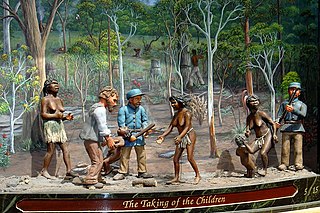
The Stolen Generations were the children of Australian Aboriginal and Torres Strait Islander descent who were removed from their families by the Australian federal and state government agencies and church missions, under acts of their respective parliaments. The removals of those referred to as "half-caste" children were conducted in the period between approximately 1905 and 1967, although in some places mixed-race children were still being taken into the 1970s.
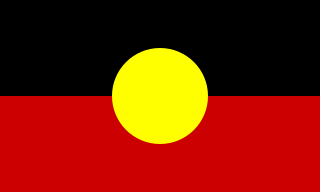
The Australian Aboriginal flag is an official flag of Australia that represents Aboriginal Australians. It was granted official status in 1995 under the Flags Act 1953, together with the Torres Strait Islander flag, in order to advance reconciliation and in recognition of the importance and acceptance of the flag by the Australian community. The two flags are often flown together with the Australian national flag.

Pemulwuy was a Bidjigal warrior of the Dharug, an Aboriginal Australian people from New South Wales. One of the most famous Aboriginal resistance fighters in the colonial era, he is noted for his resistance to European colonisation which began with the arrival of the First Fleet in January 1788.

Edward Joseph Egan is an Australian folk musician and a former public servant who served as Administrator of the Northern Territory from 2003 to 2007.
Jandamarra or Tjandamurra, known to European settlers as Pigeon, was an Aboriginal Australian man of the Bunuba people who led one of many organised armed insurrections against the European colonisation of Australia. Initially employed as a tracker for the police, he became a fugitive when he was forced to capture his own people. He led a three-year campaign against police and European settlers, achieving legendary status for his hit and run tactics and his abilities to hide and disappear. Jandamarra was eventually killed by another tracker at Tunnel Creek on 1 April 1897. His body was buried by his family at the Napier Range, where it was placed inside a boab tree. Jandamarra's life has been the subject of two novels, Ion Idriess's Outlaws of the Leopold (1952) and Mudrooroo's Long Live Sandawarra (1972), a non-fiction account based on oral tradition, Jandamurra and the Bunuba Resistance, and a stage play.

Windradyne was an Aboriginal warrior and resistance leader of the Wiradjuri nation, in what is now central-western New South Wales, Australia; he was also known to the British settlers as Saturday. Windradyne led his people in the Bathurst War, a frontier war between his clan and British settlers.
Indigenous Australians are people with familial heritage from, and/or recognised membership of, the various ethnic groups living within the territory of present day Australia prior to British colonisation. They consist of two distinct groups, which includes many ethnic groups: the Aboriginal Australians of the mainland and many islands, including Tasmania, and the Torres Strait Islanders of the seas between Queensland and Papua New Guinea, located in Melanesia. The term Aboriginal and Torres Strait Islander peoples or the person's specific cultural group, is often preferred, though the terms First Nations of Australia, First Peoples of Australia and First Australians are also increasingly common; 812,728 people self-identified as being of Aboriginal and/or Torres Strait Islander origin in the 2021 Australian Census, representing 3.2% of the total population of Australia. Of these Indigenous Australians, 91.4% identified as Aboriginal; 4.2% identified as Torres Strait Islander; while 4.4% identified with both groups. Since 1995, the Australian Aboriginal flag and the Torres Strait Islander flag have been official flags of Australia.

The Thaua people, also spelt Thawa and Dhawa, and also referred to as Yuin (Djuin), are an Aboriginal Australian people living around the Twofold Bay area of the South Coast of New South Wales.
Tjandamurra (Jandamarra) "Janda" O'Shane is a Murri Aboriginal Australian who at age six was the victim of a fire attack whilst playing at a schoolyard in Cairns, Queensland on 10 October 1996. He is the nephew of New South Wales magistrate Pat O'Shane, and Aboriginal and Torres Strait Islander Commissioner Terry O'Shane. O'Shane's given name comes from the Aboriginal resistance fighter Tjandamurra, and is sometimes transliterated as 'Jandamurra'.

The Australian frontier wars were the violent conflicts between Indigenous Australians and primarily British settlers during the colonial period of Australia.

William Lee, also variously known as William Smith and William Pantoney until 1816, was an Australian pastoralist and politician. He was a member of the New South Wales Legislative Assembly between 1856 and 1860. Lee was a foremost pioneer of British colonisation in New South Wales, being amongst the first white men to take land in the Bathurst, Capertee, Bylong, Bogan and Lachlan River regions.

Bunuba is an Australian Aboriginal language spoken by some 41 older Bunuba adults, most of whom live in Junjuwa, an Aboriginal community in Fitzroy Crossing in Western Australia. Bunuba is not related to the Pama-Nyungan language family that spans the majority of Australia; however, it is a relative of Guniyandi. Both are subgroups of the Bunuban language family. Bunuba consists of two dialects, 'light' and 'heavy' Bunuba.

The Bunuba are a group of Indigenous Australians and are one of the traditional owners of the southern West Kimberley, in Western Australia. Many now live in and around the town of Fitzroy Crossing.

Cleverman is an Australian television drama program based on an original concept by Ryan Griffen. The series premiered on 1 June 2016 on SundanceTV in the United States and 2 June on ABC in Australia.
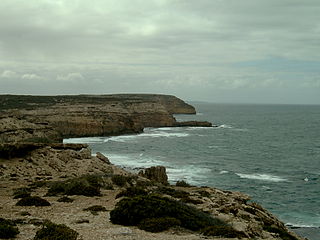
The Waterloo Bay massacre, also known as the Elliston massacre, was a clash between European settlers and Aboriginal Australians that took place on the cliffs of Waterloo Bay near Elliston, South Australia, in late May 1849. Part of the Australian frontier wars, the most recent scholarship indicates that it is likely that it resulted in the deaths of tens or scores of Aboriginal people. The events leading up to the fatal clash included the killings of three European settlers by Aboriginal people, the killing of one Aboriginal person, and the death by poisoning of five others by European settlers. The limited archival records indicate that three Aboriginal people were killed or died of wounds from the clash and five were captured, although accounts of the killing of up to 260 Aboriginal people at the cliffs have circulated since at least 1880.
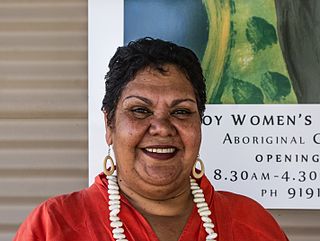
June Oscar is an Australian Aboriginal woman of Bunuba descent, Indigenous rights activist, community health and welfare worker, film and theatre, and since 2017 and as of February 2022 Aboriginal and Torres Strait Islander Social Justice Commissioner.
The Gooniyandi, also known as the Konejandi, are an Aboriginal Australian people in the Kimberley region of Western Australia.
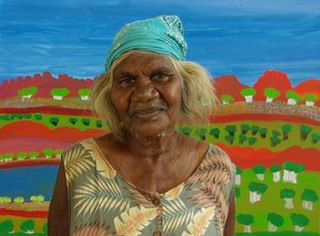
Munmarria Daisy Andrews, known professionally as Daisy Andrews, was an Australian artist originally from the Walmajarri desert tribe. After taking up artwork later in life – initially illustrating the personal stories of fellow community members – Andrews began exhibiting her paintings in group and solo showings across Australia. She was known for her vividly red landscapes showcasing the mountain ranges of the Great Sandy Desert. In 1994, she received the main Telstra award from the National Aboriginal and Torres Strait Islander Art Awards (NATSIAA) for her painting Lumpa Lumpa landscape.
Michelle "Mitch" Rose Torres, also credited as Michelle Torres-Hill, is an Aboriginal Australian actress, director, journalist, playwright, producer, radio presenter, and writer. She began as an actress, playing the main role in the 1986 film BabaKiueria. She then worked as a journalist, becoming the first Indigenous Australian on-air presenter for SBS Television, and working at ABC Television. After this she worked for Indigenous radio stations as a broadcaster, producer, and presenter. She moved into filmmaking in the mid-1990s, with her first short film Promise for SBS-TV. Among her works include the documentary Jandamarra's War and the play Muttacar Sorry Business.